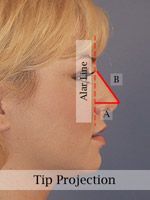Pendejo
Fire
- Joined
- Apr 15, 2019
- Posts
- 18,785
- Reputation
- 29,545
Nasal tip projection
-What it is and how to measure it:

Nasal tip projection (see diagram) assesses how far out from the face the tip of the nose protrudes. There are several accepted methods of measuring nasal tip projection, but the most common one described is the Goode method.First the alar line is drawn, which is a line running perpendicular to the Frankfort plane. The alar line runs thru the alar-facial crease, which is where the nasal base attaches to the cheek (see dashed line). A measurement is then taken from the nasal tip to the alar line (“A” in the diagram) and compared to the distance from the nasal tip to the nasal starting point (“B” in the diagram). The ratio of “A” to “B” is a measure of tip projection and should ideally be 0.55-0.60 in most patients. When this ratio is higher than ideal (tip of the nose is positioned too far from the face), the nose is considered overprojected. When the opposite exists and the ratio is lower than ideal (tip of the nose too close to the face), the nose is considered underprojected.
Goode's method diagram:

Illustration of both methods:

Your nose is also overprojected if your SDLNT (Sagittal distance from lip to nose tip) makes more than 60% of the whole sagittal length of the nose and/or if your SDLNT measures more than 2 cm.


A low radix accentuates the appearance of an overprojected nose.
-How to fix an overprojected nose:
Nasal Tip Deprojection
Rhinoplasty For An Over Projected Tip
The goal in rhinoplasty for an overly projected nasal tip is to bring the tip of the nose closer to the face (deprojection of the nasal tip) while maintaining proportion with the remainder of the nose and face. As noted above, the bridge height is often times excessively high in patients with an overly projected nasal tip. Therefore, it is frequently necessary to reduce the bridge height while bringing the nasal tip in closer to the face.
In some rhinoplasty patients, deprojection of the nasal tip simply involves reducing the size of what is commonly referred to as the domal cartilage. The domal cartilage is the highest point of the lower lateral cartilage as it sticks out from the face. If this portion of the lower lateral cartilage is excessively prominent, very careful reduction of the dome can be undertaken to deproject the nasal tip. Some rhinoplasty terms that refer to this type of nasal tip deprojection maneuver include: domal truncation, crural overlay, and vertical dome division. In other rhinoplasty patients, the entire lower lateral cartilage has to detached, moved and reattached to accomplish the desired change in tip projection. Depending on the rhinoplasty surgeon’s expertise and experience, both methods can be done successfully using either an open or closed rhinoplasty approach.
In many cases where the nasal tip is being deprojected, the nose also has to be rotated slightly to maintain proper esthetic balance. To some degree this is directly proportional to the amount of tip deprojection being performed.
Algorithm developed to help simplify the approach to deprojection.
Analysis begins with evaluation of the radix. Asterisk indicates that full-transfixion incision can be added to these procedures to allow further retrodisplacement. MCO indicates medial crural overlay; LCO, lateral crural overlay.

-Before & Afters:






A low radix can be fixed with a radix graft, an implant or fillers such as Radiesse.


Jaw surgery could make the nose look less overprojected as well:
Some more in-depth information regarding this:




